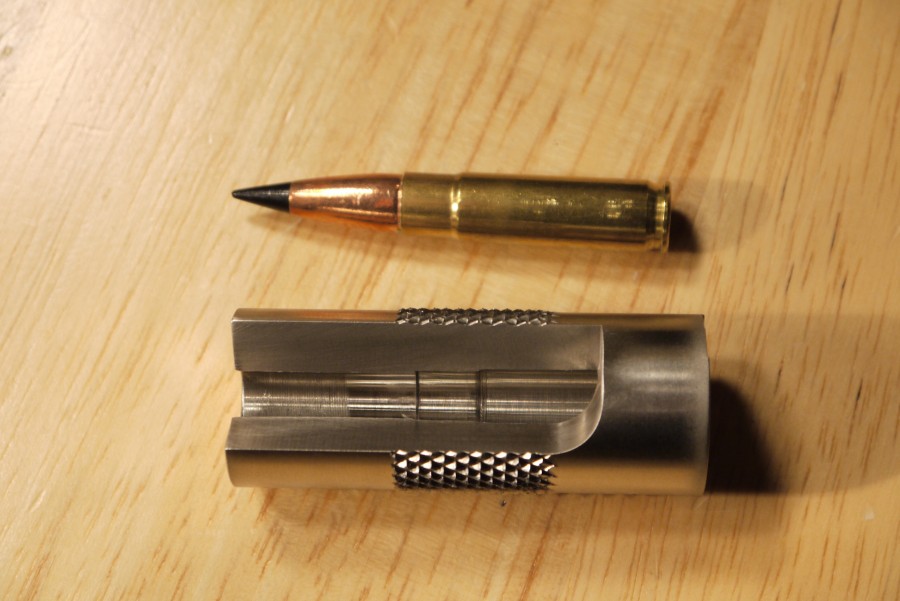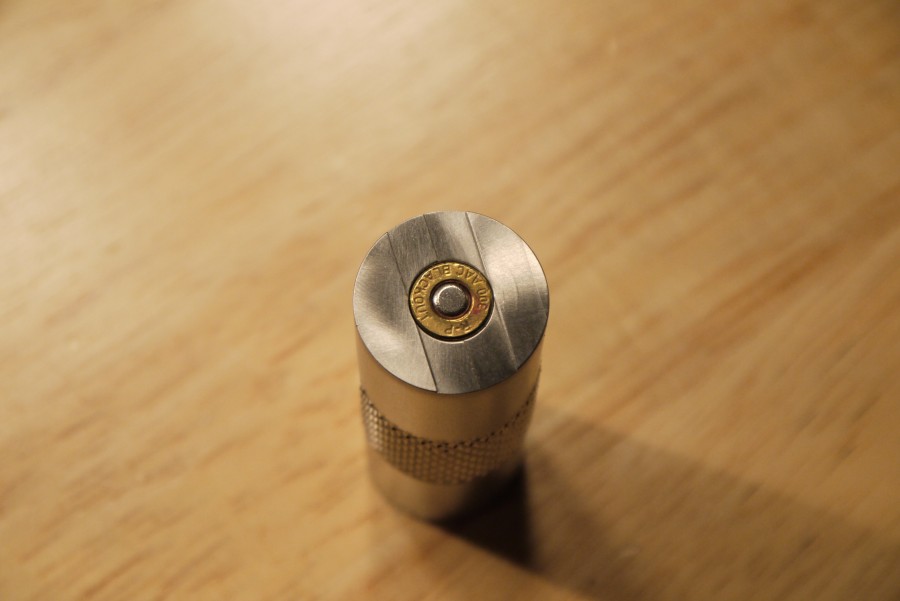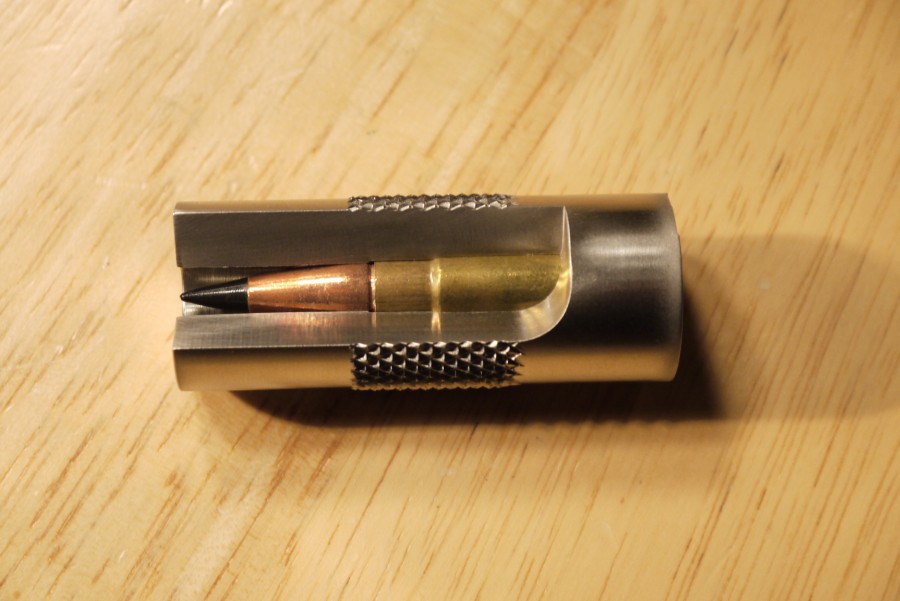When you’re handloading ammunition, there has never really been a good way to check that all of the dimensions are correct. Sure you can grab your calipers and check every dimension of every finished round, but that’s time consuming and inefficient. Especially when you’re slicing up existing 5.56 brass into 300 BLK brass, you want to be doubly sure that your handloads will fit perfectly in the chamber without any issues. That’s where something like this slot gauge comes in handy, from Sheridan Engineering . . .
The concept is simple: the gauge mimics a 300 BLK chamber and lets you double check that all of the dimensions are correct. The barrel end of the gauge is calibrated to ensure the proper COL of a loaded bullet. The breech end has markings that let you check that the shoulder is in the right position. And the open design allows you to visually inspect whether your hand-rolled round has any imperfections that might cause an issue.
I know what you’re thinking. “Hey Foghorn, it’s just a die! How long could the review possibly be?!” And while I may have just covered the basics of the die’s functionality, I wanted to take a second and talk about the quality of this thing, too.
Sheridan Engineering might not be a big name in the die making industry, but they put a ton of time and effort into this thing. Everything about it is well thought out, from the way the headspace gauge is designed right into the base to the serrations on the side that let you grip it even when your hands are covered in lube. It’s a well-polished piece of equipment and for those who load their own 300 BLK ammo I highly recommend spending the money to pick one up. It’ll save you having to bust out the calipers each time, and make your workflow much simpler.
Sheridan Engineering Slot Gauge
MSRP: $60
Overall Rating: * * * * *
I really wish that I had one of these for each caliber I load. Having a visual reference to make sure that my rounds are in-spec is worth the $60 to me.







Filing this in my “for the future” file. Nick, would you really check every round you loaded, or would you likely just “spot check” each lot?
This is really cool! Not sure if it’s worth the price though. I don’t think I could drop $60 per caliber…
In my opinion You should have them for every AR type Rifle Cartridge especially if you are forming cases from a different caliber one good example is the .300 Blackout made out of .223 Brass!
I like the idea of a go/no-go gauge being kind of open like that. I have spotty issues with my 147 grain projo’s not wanting to chamber.
Those are slick, aren’t they? I checked their site and they make ’em for .50 Beowulf, 6.5 Grendel (yea!), .300 BLK (yea!) and soon .223 (yea!) and 6.8 SPC. I don’t think I’d check every .300 BLK round, but I would check every 6.5G round. I’d be more worried about a round that was going 600-800 yards downrange versus one going 300 yards. Now if they only made one for 6mmx45 then it’d cover all the AR rounds I load…
Check a lot of the remington factory subs (especially early lot numbers). You will see why everyone who was shooting them in non-ar15s were having light primer strikes.
TL;DR. Remington loaded 8/10 of them on the no go side of the Sheridan gauges so that they would be sure to fit in a pmag.
Lol, BLK
The link to the website has the price at $36, because it’s linked to the gauges, and you are reviewing the Slot Gauges.
Here’s the link to the Slot Gauges
http://www.sheridanengineering.com/index-2.htm
I use this gauge regularly and would highly recommend if you load your own ammo.
Why are your hands covered in lube?!!!
TMI Nick TMI! !
I don’t have the brand nick reviewed (I like the open concept) it I do have them from jp for 223 Wylde and 40 s&w and 9mm.
I gage everything I make. It doesn’t take that long and you can be sure everything will chamber. If its worth doing its worth doing right.
So, simple milling off piece of material adds $24 to price? I’m in wrong trade!
This gauge is great. I ordered 100 rounds from a small company and it rejected every round. I took a caliper found what was wrong according to SAAMI and got my full refund. The non-slotted gauge is cheaper. I am surprised this article is up now. This gauge has been around for awhile.
Maybe Nick just discovered it? I think this isn’t the first time you’ve felt it necessary to comment on the coverage something that’s “been around a while,” simply because you already knew about it. Lots of other people didn’t. Would you prefer every post was run past you first, to make sure it meets your standards?
As my dad would say, “Stifle yourself.”
Wow…did i upset you? So sorry…I will tone down. If it is a paid position, go ahead and run reports by me. I will let you know if old news or not. Sorry
@Shawn, why didn’t you share your knowledge with us sooner?
Perhaps Nick could cover the case cutoff tool that can be used with the Harbor Frieght chop saw. It’s spring loaded and I can cut around 800 pcs an hour with it. FYI 300blktalk.com is a must visit forum for blackout. It’s ran by Rob Silvers
Because you guys are the professionals in the field. Me, low man on the pole. If i can find useful for reloading, my assumptions is that the pros would already now all about it especially in a caliber that one swears by.
These types of gages have been used by benchrest and accuracy reloaders for years and years.
Since most barrel blanks are 28″ long, and most shooters want a 24 (or shorter) barrel, gunsmiths would keep the 4″+ stubs, mark what they were, then when a customer wanted an ammo gage, they’d run a reamer into the stub, then mill off a couple of steps, then run a mill into the shoulder/neck/throat area of the chamber and wha-la, there you go.
This idea has been around since, oh, the 1950’s, when PO started his Ackley craze and everyone was blowing shoulders forward on cases.
.223, arguably the most shot center fire caliber in the US, and it’s “coming soon”?
Perhaps they started with the “more handloaded” or at least the “handloads with the least well-known specs,” because they saw a larger need for people who needed help getting it right in those calibers.
I think it’s more because the .300 cases are formed from .223 cases & thus there is more room for error/out of spec. brass.
First time I’ve seen these cutaway gauges too.
Yeah, but I was also speaking to the fact that they made a couple other “unusual calibers” (.50 Beowulf & 6.5 Grendel) before .223, besides the 300 BLK.
Your explanation about a “conversion case” makes a lot of sense, though.
An alternative, BTW, is to see what your rifle’s chamber is in size. This gage assumes your rifle’s chamber is SAAMI spec. This is not necessarily a good assumption. What you want to know when reloading is “What is the dimension of the rifle I have in front of me?” Arguing that “SAAMI says X, Y and Z” is like telling me that the IRS tax code says X, Y or Z. SAAMI isn’t a standards organization, and chamber reamers wear.
The product we gunsmiths use for this measurement of chambers and bores is called “Cerrosafe” and what you do is plug the bore ahead of the chamber, clean chamber, melt the Cerrosafe, pour into chamber, allow it to cool, punch the casting out from the muzzle, let it finish cooling for 30 minutes, then measure with some precision measurement tools. Do not wait longer to measure, as the Cerrosafe will grow a bit if you wait.
A set of calipers is good enough if you’re experienced in using calipers, but NB that for the inexperienced, calipers can give readings of +/- .003″ easily.
D.G.,
Thank you for this.
I’ve been having problems with surplus 147 grain bullets not wanting to seat all the way. Bolt out of battery by just enough on the AR platform rifle.
My 110 barnes coppers feed just fine.
I’m wondering if the ogive is too obtuse with the 147’s?
I guess that I am missing something. If you cut the brass properly, then set up the dies per manufacturers spec, then make sure you are seating the bullet within spec, then why would you run each load through one of these? Or is this meant to be one more fail safe so you don’t end up minus digits?
You’re basically correct. If you have a standard chamber, cut to standard practices with matching go/no-go gages, you load to the OAL, case length in the books and you’re done.
These gages (per above) have been used by the benchrest/long-range crowd because so many of them use wildcat rounds, trying out new ideas with one-off chambers and making their brass from a parent case with necking up/down, blowing shoulders forward or bumping them back, etc. So the idea was that you’d cut a barrel stub with the same chamber you had used to cut the chamber in the barrel, and that would provide the handloader with a way to easily set “trim-to” lengths for cases and maximum OAL’s for a particular bullet, which also might be completely new.
For “standard” chambers, once I get my reloading dies set, I rarely even check them.
Really, the only two things most people have to check for is their “trim-to” length and whether or not their selected bullet is engaging the lands when chambered. The easy way to check for these issues is to use smoke on the case mouth (chamber the case, remove and see if the smoke was disturbed on the face of the case mouth) and then load a bullet into an unprimed and empty case that has been properly sized and apply smoke to the bullet. Carefully chamber that. See if the bullet shows evidence of the bullet engaging the lands. If there is, you need to set your seating die to seat the bullet further into the neck.
avatar test
Calvin. Yes!